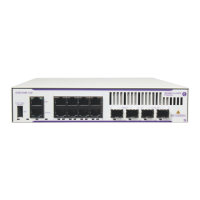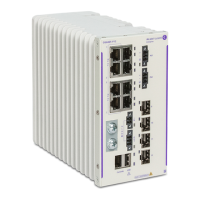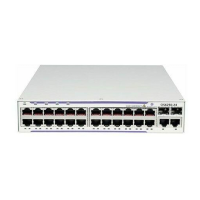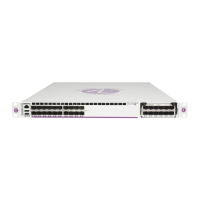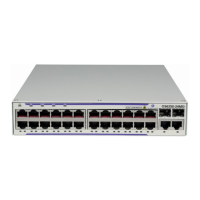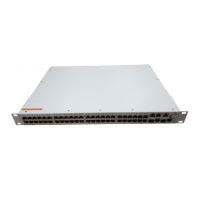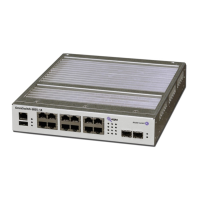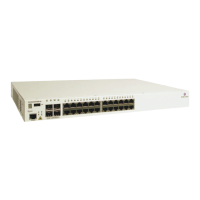Do you have a question about the Alcatel-Lucent OmniSwitch 6560 and is the answer not in the manual?
Defines the specific OmniSwitch 6560 models covered by this guide.
Identifies the intended audience for this hardware users guide.
Provides guidance on when to consult this document for switch hardware.
Outlines the hardware-related information included in this manual.
Clarifies the scope by stating what hardware topics are excluded from this guide.
Explains the structure and organization of the content within the guide.
Guides users through the initial setup and first-time use of the switch.
Helps users understand basic switch functions after initial setup.
Provides information on connecting the switch to a network environment.
Information on CLI reference guide for anytime consultation.
Technical specifications and procedures for OmniSwitch 6560 hardware.
Complete reference for all CLI commands supported on the OmniSwitch.
Procedures for preparing a switch for network integration and management.
Network configuration procedures and major software feature information.
Information published by Alcatel-Lucent’s Customer Support group.
Critical problem reports and feature limitations for the current release.
Describes hardware and software safeguards for preventing data flow loss.
Information on how redundant power supplies ensure continuous operation.
Ability to add or replace hardware components without powering off the switch.
Explains the system's built-in sensors and user-driven monitoring methods.
Procedures for the physical installation of the switch hardware.
Lists the necessary tools and materials for hardware installation.
Guidelines for preparing the installation environment for the switch.
Important recommendations and guidelines to protect equipment from surges.
Steps for safely unpacking and physically installing the switch.
Lists the components typically included with the OmniSwitch.
Notes on the weight of the switch and handling precautions.
Guidelines for ensuring proper airflow and ventilation for the switch.
Instructions on how to physically mount the switch.
Procedures for connecting network and management cables.
How to establish an initial console connection to the switch.
Default parameters for the serial console connection.
Steps for powering on and starting the switch.
Explanation of status LEDs during the switch boot process.
Guides users through the initial login and configuration steps.
Instructions for initial login using default credentials.
Enabling remote access methods like Telnet, FTP, and SNMP.
Procedure to change the default administrator login password.
Configuring the switch's time zone for accurate logging and timestamps.
Setting the current date and time on the switch.
Configuring administrative contact, system name, and location.
Ensuring configured settings are persistently saved on the switch.
Provides front and rear panel views and specifications for chassis models.
Explains the meaning of status LEDs on the chassis front panel.
General recommendations and guidelines for mounting the switch.
Best practices for installing the switch in racks or other enclosures.
Crucial guidelines for ensuring proper airflow and preventing overheating.
Importance and installation of blank panels for airflow and component protection.
Step-by-step instructions for installing the chassis in a standard rack.
Instructions for placing the switch on a flat surface as a standalone unit.
Lists the various power supply models supported by OmniSwitch 6560.
Details and specifications for the 300W AC PoE Power Supply Unit.
Details and specifications for the 600W AC PoE Power Supply Unit.
Details and specifications for the 920W AC PoE Power Supply Unit.
Details and specifications for the 150W AC Power Supply Unit.
Details and specifications for the 150W DC Power Supply Unit.
Details and specifications for the internal AC power supply.
Instructions for connecting DC power supplies to the chassis.
Procedure for installing power supply units into the chassis.
Procedure for safely removing power supply units from the chassis.
Instructions on how to properly ground the switch chassis.
Information on monitoring chassis components and their status.
How to view status information for installed modules in chassis slots.
Checking the switch's internal temperature and operating status.
Explanation of temperature error levels and conditions.
Describes the event notification sent upon total power loss.
Details on SNMP traps sent upon power failure detection.
Syslog message format generated upon power failure.
Information on Link OAM PDUs generated during dying gasp events.
Explanation of Power over Ethernet technology and its benefits.
General specifications for Alcatel-Lucent's Power over Ethernet support.
Default configuration parameters and values for PoE settings.
Lists available PoE wattages based on installed power supplies.
Command to view the type and status of installed power supplies.
Command to view current PoE status and settings for each port.
Information on PoE-related CLI commands and default settings.
How powered devices are classified to adjust maximum power allocation.
Information on enabling support for the IEEE 802.3bt standard.
Procedures for enabling and managing PoE service on ports.
Setting maximum power limits for individual ports.
Setting maximum power limits for all ports within a slot.
Specifying priority levels (low, high, critical) for connected devices.
Enabling legacy IP phone support for capacitive detection.
Feature for managing power budgets with lower available power.
How power is managed when the PoE budget is constrained.
Enabling or disabling the priority disconnect function.
Scenario detailing priority disconnect with uniform priority levels.
Scenario detailing priority disconnect when a high priority device connects.
Scenario detailing priority disconnect when a low priority device connects.
Behavior of the system when priority disconnect is turned off.
Using CLI commands to monitor PoE statistics and port status.
Statement of compliance with essential requirements and other EU directives.
Information regarding end-of-life product disposal in EU member states.
Disclosure of hazardous substances in products according to China RoHS.
Disclosure of hazardous substances in products according to Taiwan RoHS.
Warning regarding chemical exposure and potential health risks.
List of safety and EMC standards that the product complies with.
Details on electromagnetic interference and compatibility standards met.
List of environmental testing standards the product adheres to.
Compliance statement for FCC Class A digital device regulations.
Statement regarding Canadian radio noise emissions limits.
Japan Approvals Institute of Telecommunications Equipment certification.
Warning for potential radio interference in domestic environments.
Statement regarding Korea's electromagnetic emissions regulations.
Voluntary Control Council for Interference compliance statement.
Warning for potential radio interference in residential environments.
Warning about invisible laser radiation when the unit is open.
Warning against installing exposed network cables outdoors.
Safety warnings presented in multiple languages for broader understanding.
Emphasizes the importance of keeping blank panels installed.
Safety precautions to take during an electrical storm.
Requirement for qualified personnel to perform installation.
Warning about potential exposure to invisible laser radiation.
Warning to keep hands away from power supply bays while operating.
Safety instruction to disconnect power before servicing or moving.
Emphasis on the necessity of proper electrical grounding.
Warning regarding the correct connection of DC power supply ground wires.
Reminder to read the safety information in the Getting Started Guide.
Requirement for installing equipment in a secure, access-restricted location.
Warning about electrostatic discharge (ESD) and handling procedures.
| Brand | Alcatel-Lucent |
|---|---|
| Model | OmniSwitch 6560 |
| Category | Switch |
| Language | English |

